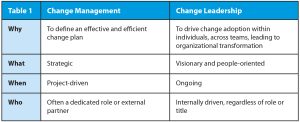
CHANGE LEADERS – By Wendy Heckelman, Ph.D.
Trainers can be strategic partners as organizations evolve
In the business world, change is ever present, often shaping the landscape of industries and changing how companies interact. That’s especially so in the life sciences sector. Companies continually redefine strategies, restructure and adjust to market shifts; however, the true impact of these changes is not measured in boardroom presentations or high-level strategies, it is measured in the daily experiences of every individual within the organization.
The well-known transformative change models aim to target reform at a high level, encompassing everything from reimagining structures to strategic realignments and refined communication practices. However, they often fall short in targeting the unsung heroes of change — middle management and front-line leaders.
These plans are designed to address critical organizational concerns on a macroscale. What often remains elusive is the translation and execution of these sweeping strategies throughout the organization’s ranks. These are the missing links — the crucial bridge between visionary strategy and on-the-ground implementation.
Addressing these missing links is critical to ensuring successful implementation across all organizational levels. That is where the role of change leaders comes into play – L&D professionals play a crucial role as strategic partners by training and preparing employees to lead and adapt to change. Involving change leadership throughout the process of transformation ensures comprehensive and inclusive reforms that target the most critical elements of an organization.
Change Leadership: The Overlooked Key
Change management experts like John Kotter, Larry Bossidy and Ram Charan have highlighted the importance of change agents for decades. These experts speak about the importance of execution planning and working with change agents throughout multiple levels of the organization. Still, many organizations do not fully understand the power of empowering every single leader to be a change agent through targeted development of one critical skill set – change leadership.
Change leadership refers to leaders’ ability to translate and execute organizational strategy by driving change adoption among individuals and across groups.
Table 1 shows what distinguishes change leadership from change management.
 The Change Leadership Skillset
The Change Leadership Skillset
Organizational development expert Edgar Schein highlights the significant role leaders play in shaping culture and overseeing the process of change within an organization. Leaders hold the responsibility of articulating the business case for change, steering teams through transition, and ensuring active engagement and motivation among all the organization’s members.
When leaders are provided with the necessary tools and resources to successfully navigate and implement change, organizations enhance their prospects of attaining the intended results. These five core areas are a roadmap for those seeking to enable leaders to successfully navigate the complexities of organizational transformation:
1. Commit to the Change
Leaders need the training and resources to understand the importance and purpose of the change. Once they embrace and commit to organizational transformation, they are better suited to lead others to do the same.
2. Construct a Risk Mitigation Plan
Leaders have a unique vantage point that reveals risk in any change scenario. With proper training in risk assessment methodologies, decision-making frameworks and strategic thinking, they will be positioned to work with their team(s) to identify and proactively mitigate risks.
3. Create High-Performing Teams Focused on Results
The No. 1 challenge for most leaders is keeping their teams engaged and focused on the business during times of change. Leaders who understand team effectiveness are better prepared to jump start their teams, whether there is are structuring, new leadership or even new strategic imperatives.
4. Coach Individuals Through Change and Transition
As change unfolds, coaching becomes a pivotal aspect of navigating the transformation journey … but it is not the type of coaching that most leaders are accustomed to using. Leaders need transition coaching skills, to enable them to support individuals through the change process.
5. Calibrate to Ensure Success
Continuous evaluation and adjustment are essential in driving successful change. Leaders should be comfortable with data analysis, feedback mechanisms and other complementary techniques needed to evaluate progress, identify gaps and make informed adjustments to change strategies.
Embracing Change Leadership
While change management strategies can be transformative, change leadership stands as the linchpin for successful plan implementation. Empowering leaders at all levels to champion change, communicate effectively and navigate the intricacies of change will ensure a smoother transition toward desired outcomes.
Organizations that prioritize change leadership will not only survive but thrive in the face of ongoing change and strategic transformation.
 Wendy Heckelman, Ph.D., is president and founder of WLH Consulting. Email her at wendy@wlhconsulting.com or connect through linkedin.com/in/wendy-l-heckelman-phd.
Wendy Heckelman, Ph.D., is president and founder of WLH Consulting. Email her at wendy@wlhconsulting.com or connect through linkedin.com/in/wendy-l-heckelman-phd.









